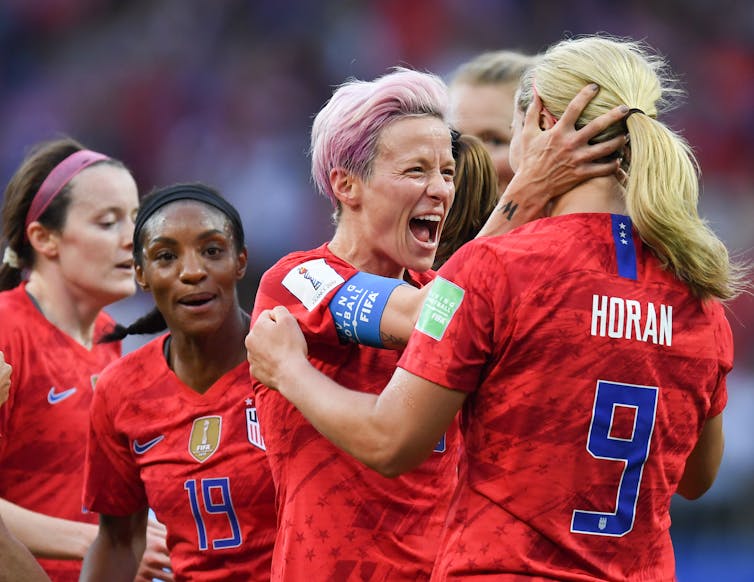
When the 2023 Women’s World Cup kicks off on July 20, fans in the UK will have access to a wealth of media coverage. All games will be shown on TV, while in print and online, analysis of the teams, and tournament has already begun.
The tournament itself is likely to be the most attended women’s sporting event ever. But this interest in the sport has not happened overnight. Media coverage is contributing towards the growing interest in women’s football – and our perceptions of the sport.
My new research, conducted with colleagues at Durham University and Mississippi State University, is the first research study to examine print media coverage of women’s football in the UK over time.
We compared print media coverage of the 2015 and 2019 FIFA Women’s World Cups, looking at the quantity and quality of articles printed in five UK newspapers: three broadsheets – the Guardian, the Independent (replaced by the Telegraph for 2019 as the Independent moved online only) and the Times; and two tabloids – the Sun and the Daily Mirror. We also carried out 49 interviews with fans about their thoughts on the coverage.
Also read: Why I’m Crazy About Women’s Football
Front-Page News
We found a massive increase in coverage for the 2019 competition. Between the 2015 and 2019 Women’s World Cups, the number of articles published by these newspapers about the competition rose from 124 in 2015 to 642 in 2019.
The number of front-page articles increased from seven in the 2015 tournament to 22 in 2019. On the back pages, the number of articles rose from five in 2015 to 40 in 2019.

There was a fourfold increase in the number of photos, from 159 in 2015 to 636 in 2019. The type of photograph used also changed: 88 percent in 2019 were shots of the players competing rather than other photographs, such as posed shots. This was up from 69 percent in 2015.
One of the fans we spoke to said:
… [the 2019 Women’s World Cup] just felt so much bigger this time, it was the focus of our summer… The national newspapers were sending out some of their biggest journalists to the World Cup, who weren’t part of that natural group of women’s football journalists.
We also looked at changes in the way women’s football was discussed in the press. In both the 2015 and 2019 tournaments, there was evidence of a move away from the sexualisation of women players that has plagued women’s sport. We found no articles referring to players’ sexual appeal.
The use of infantilising language, such as referring to players as “girls” or “ladies”, also reduced drastically between 2015 and 2019. In 2015, there were 28 references to the players as “girls” in the tabloid papers. In 2019, there were three uses of “girls” and “lady” or “ladies” in broadsheet papers and 11 in tabloids.
Instead, there were many more usages of the word “Lionesses”, representing England women as the embodiment of strength, aggression and bravery, and helping to construct a sense of national pride.
Also read: Women Players Lead the Fight Against Homophobia in Football
Critical Appraisals
A new appearance in the 2019 coverage was considered criticism of players and teams, in line with the typical reporting of men’s football. This could represent a shift towards greater gender equality, with women subject to respectful but honest evaluations based on their performance. This can also be connected to higher expectations for England’s national team following their success in recent years.
Also new in 2019 was coverage of gender inequality in football. This included the general treatment of women’s football, such as trialling rule changes at FIFA Women’s World Cup tournaments. Here there was a sense of injustice at FIFA experimenting with the laws and positioning women’s football as inferior to men’s.
Newspapers covered the need to increase opportunities for girls and women to play football. Stories included details, for instance, on how many players could not play football until their late teens due to a lack of access for girls and poor infrastructure.
Articles covered the history of women’s football, including the 1921 Football Association ban on women’s football and the impact on the development of women’s football. They also reported on pay inequality, making direct comparisons between men’s and women’s international football.
However, the fans we spoke to were critical of the “time-limited” nature of coverage of women’s football, largely reserved for the duration of the World Cup or other major tournaments, and also dependent upon the success of the England national team. Although women’s sport has become more visible in recent years, it still occupies less than 10 percent of annual print and TV coverage.
The 2023 Women’s World Cup looks set to generate another increase in column inches. Keep an eye on how newspapers talk about the matches, teams and players – it may well affect the future of the sport.
Stacey Pope, Associate Professor in the Department of Sport and Exercise Sciences, Durham University.
This article was first published on The Conversation, a global media resource that provides cutting edge ideas and people who know what they are talking about.






















